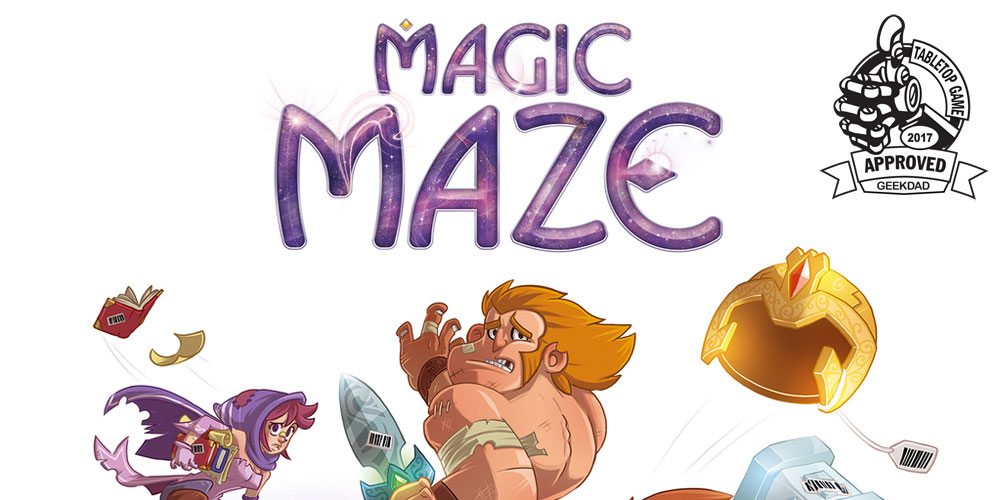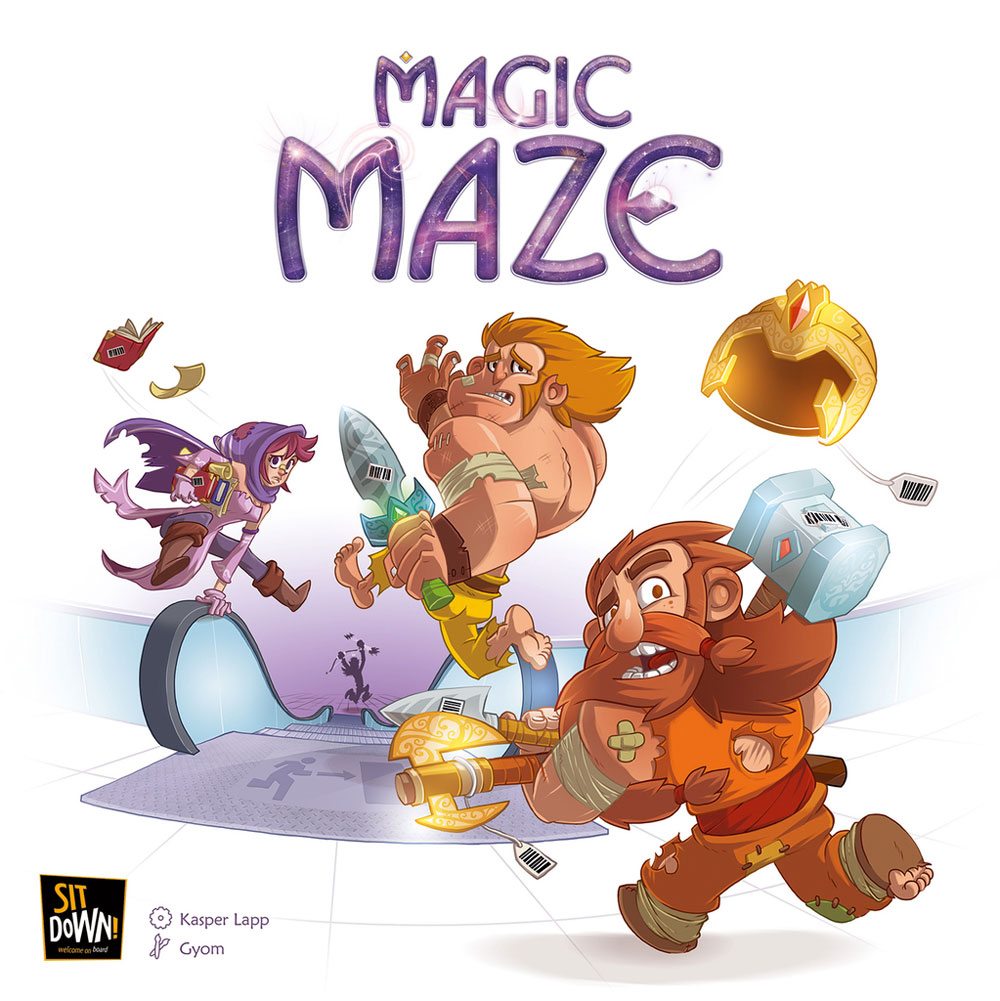What’s an adventuring party to do when they’ve lost their equipment? Why, hit up the local Magic Maze Mall and steal it, of course! Read on to find out what makes Magic Maze a Spiel des Jahres nominee and—more importantly—a GeekDad Approved title!
At a glance:
Magic Maze is a real-time cooperative game for 1 to 8 players (9 with a variant), ages 8 and up, and takes up to 15 minutes to play. It’s currently available from Sit Down! Games, the Belgian publisher for 20 Euros, but will be hitting the US through Dude Games on September 2. (I’ll update here with a link when it’s available for pre-order.) I think the age rating is about right; I have played with my 4-year-old but without the timer, and will admit that she’s terrible at the strategy. Other than, you know, shoplifting, there’s nothing inappropriate in the theme for younger kids.
Magic Maze is GeekDad Approved!
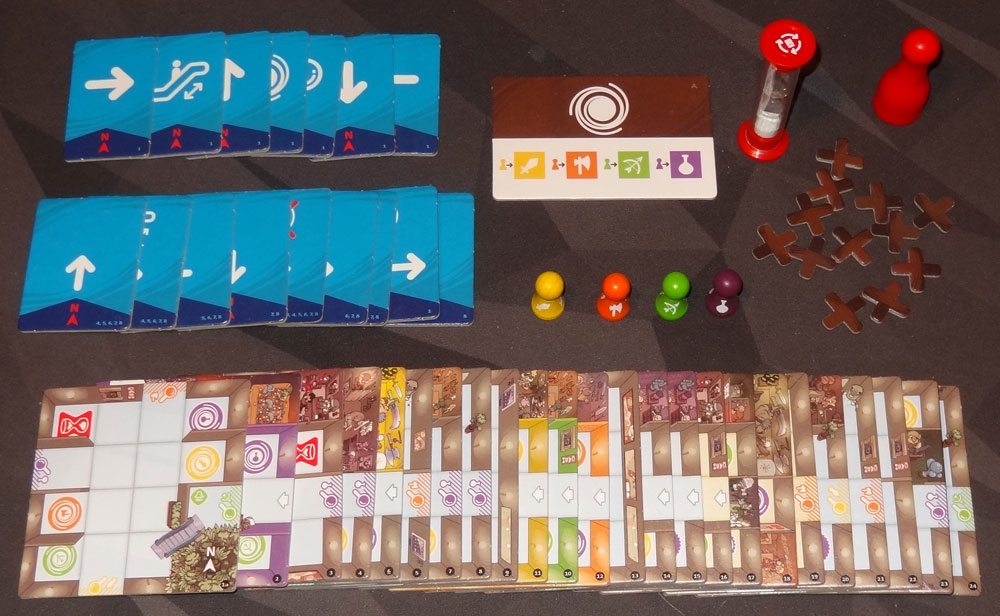
Magic Maze Components
- 24 Mall tiles
- 4 Hero pawns
- 12 Out of Order tokens
- 9 Action tiles for multiplayer games
- 7 Action tiles for solitaire games
- 3-minute sand timer
- “Do Something!” pawn
- Theft tile
- “Great Book of Challenges” score sheet
- Sticker sheet for pawns and sand timer
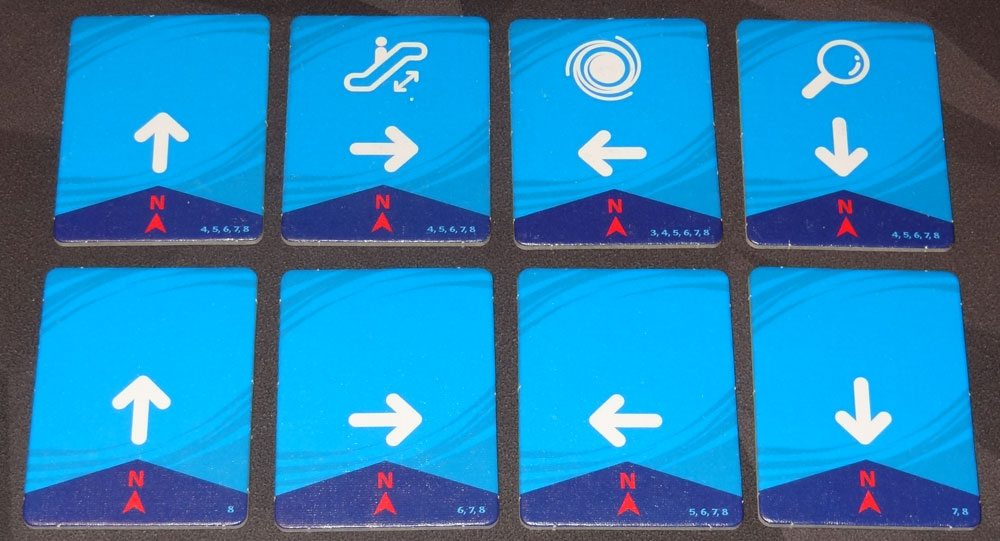
The Action tiles are sturdy cardboard: each shows some number of directions and special actions, and the tiles are labeled at the bottom with (very tiny) numbers indicating which player counts each one is used for. The solitaire Action tiles are somewhat narrower, making them easier to distinguish—though it might have been nice to just have those in a different color altogether.
The pawns are traditionally shaped wooden pawns with knobby heads, and there are optional stickers included that will mark each with its icon: sword, axe, bow, potion. The stickers are transparent with three white icons per pawn, and are intended for color-blind players to make it easier to distinguish the various heroes. I found that they don’t stick very well to the painted wood, but they stick to themselves a little better and there’s just enough overlap to hold them in place. (Tip for stickering: the bottom edge of the sticker should line up with the bottom bevel of the pawn.)
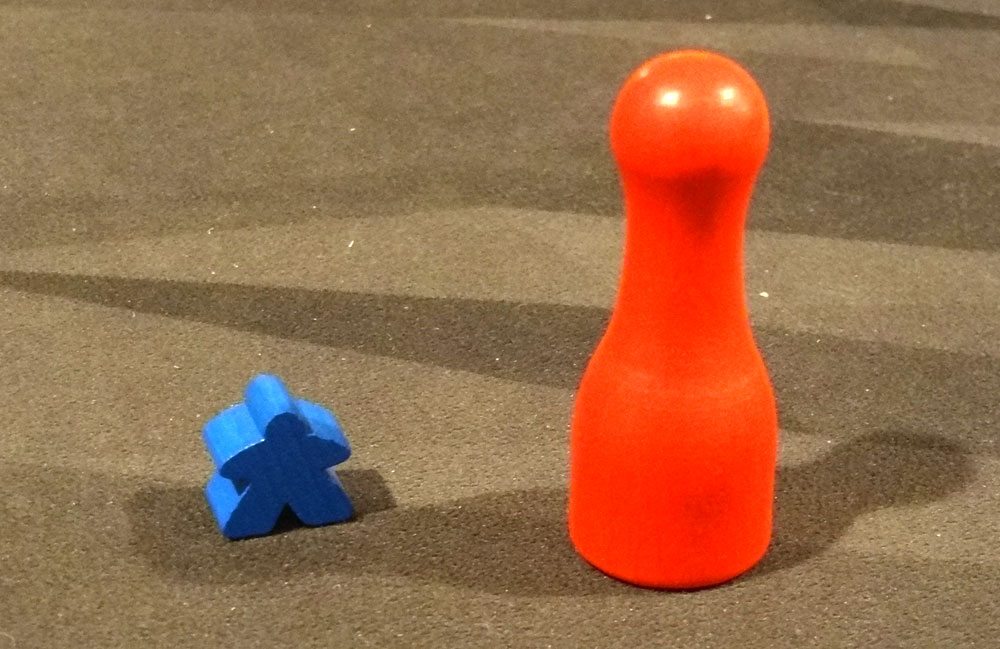
The “Do Something!” pawn is an oversized red wooden pawn, and has quickly become one of my favorite game components, simply because it’s such a funny thing—but more on that in the “How to Play” section. The Out of Order tokens are little cardboard Xs that will be used to cover up certain spots on the board.
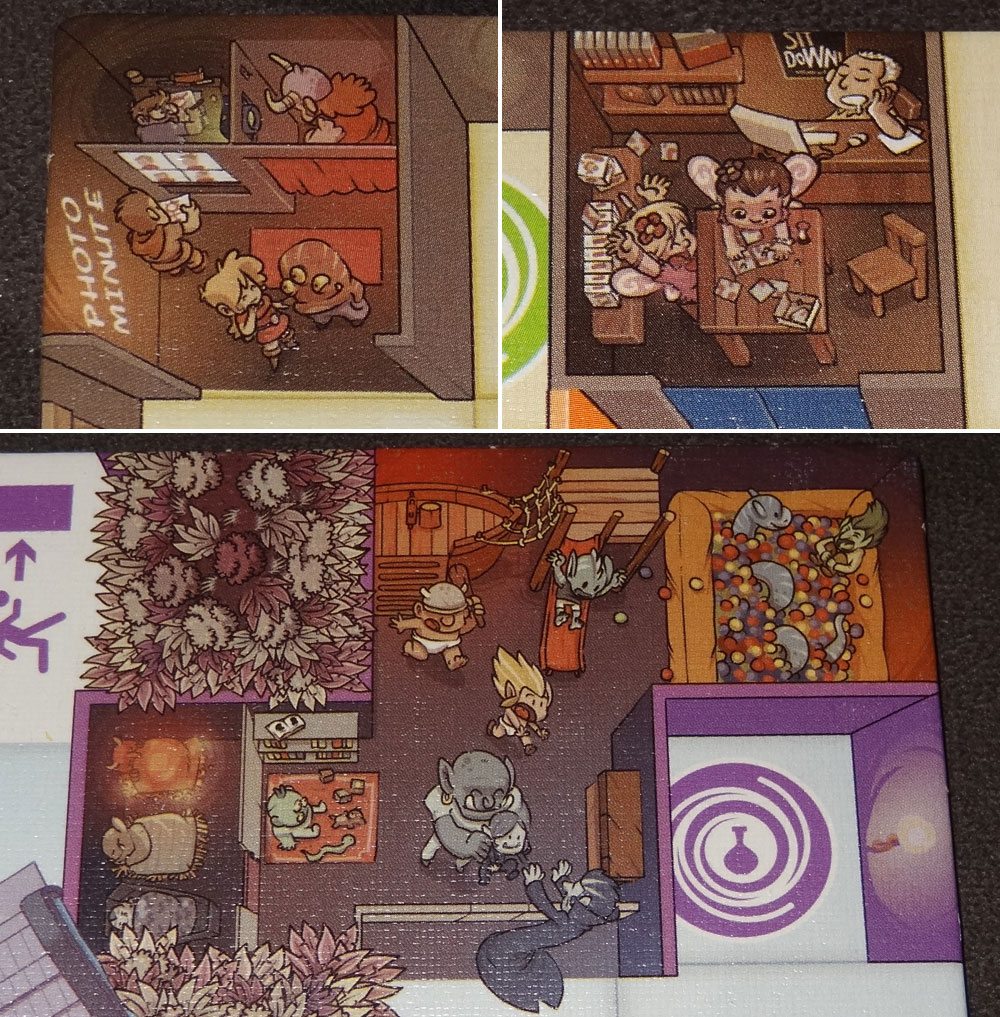
The Mall tiles are sturdy square tiles, about 3.75″ across, showing a top-down view of the mall. They have various configurations of walls, vortex spaces, stores, exits, escalators, and so on. There are some really fun details on the tiles, like a “Photo Minute” booth that shows an artist behind the screen frantically drawing portraits as the subjects sit in the booth—but you won’t be able to pay any attention to these during the game.
The box is just a large square with no insert: once you punch everything out, you’ll probably just want to store everything in baggies in the box, which is now considerably bigger than the contents.
A note on color blindness
There are various key locations in the game that have some color coding, and each is also marked with the corresponding icon, but sometimes the icon is quite small. The stores have a colored space with the hero icon in it, and a little more of that color on that tile. The exits show the international “exit” symbol, plus the entire tile has a colored border. The exit man icon also has a tiny icon in its hand.
When I played with GeekDad Randy Slavey (who is color blind), he mentioned that these key locations can be very hard to see because the colors don’t stand out enough—in particular, the yellow exit icon on a white background didn’t really show up unless he was specifically looking for it. Even without color blindness, I did find that the stores can be hard to spot easily. I’m considering adding some extra wooden cubes to my box just so we can mark key locations as soon as those tiles appear. Randy suggests that if you have issues determining color, it would help to study the various tiles ahead of time. Exits have a white background with a colored icon. Stores have a solid color background with a white icon.
Overall, the quality of the components is very nice, though the game may not be ideal for color blind players—the stickers and tiny icons may not be quite enough.
How to Play Magic Maze
The goal of the game is to get the four heroes to their matching stores and then get to the exit before time runs out.
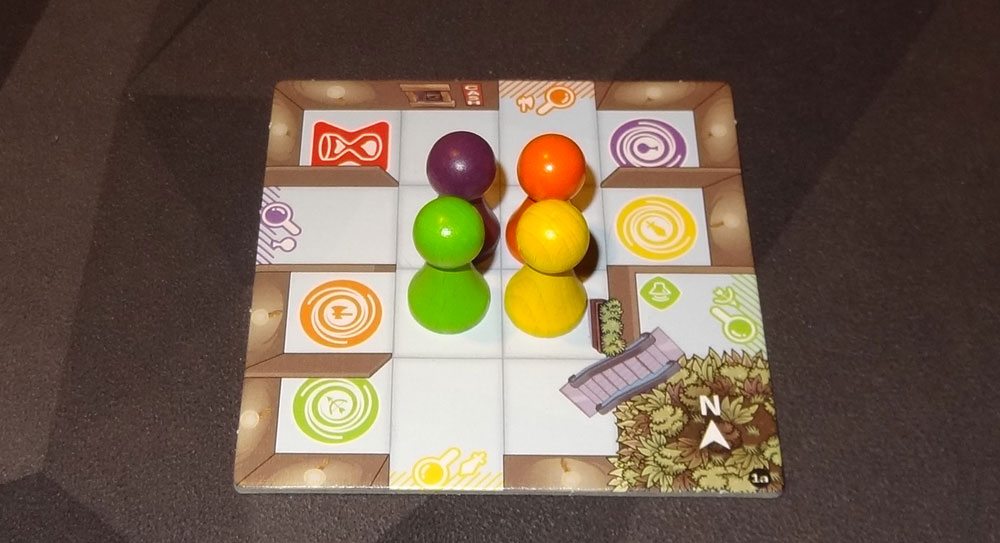
Setup
The setup for Magic Maze can vary a little from game to game: the rulebook gradually layers in the rules over the course of seven “scenarios,” by which time you will have learned all of the rules. After that, there are 10 more scenarios that have unique modifiers to change up the game.
There are some things that are common to every scenario, though:
- The entrance tile (which is double-sided rather than having the Magic Maze logo on the back) is placed in the center of the table, with the four pawns randomly placed in the four central spaces.
- Some number of Mall tiles will be shuffled together in a face-down pile.
- Each player gets one Action tile (using the tiles marked with the player count); make sure the North arrow on the action tiles is oriented in the same direction as the North arrow on the entrance tile.
- The sand timer, “Do Something!” pawn, Theft tile, and Out of Order tokens are set nearby.

How to Move and Explore
You don’t take turns in Magic Maze; everyone plays at the same time. You are allowed to use only the actions on your Action tile—everyone has at least one cardinal direction, and some players will also have Escalator, Warp, and Explore. When you move, you may move any of the four pawns in the direction(s) shown on your tile, as many spaces as you want, as long as you don’t pass through any walls or other pawns.
If you have the Escalator action, you (and only you) may move pawns up and down escalators.
If you have the Warp action, you may pick up any pawn from anywhere and put it on a vortex of its matching color. It’s important to note that the vortices are destinations, not origins. You don’t have to be standing on a vortex in order to warp—you just end up on one.
If you have the Explore action, you are responsible for drawing and placing new tiles. When a pawn is standing on an exploration space (on the edge of a tile) of its matching color, then you draw a tile from the stack and place it face-up, with the little white arrow matching up to the exploration space. The tiles will be offset from each other by one square, so the mall is not a straight grid.
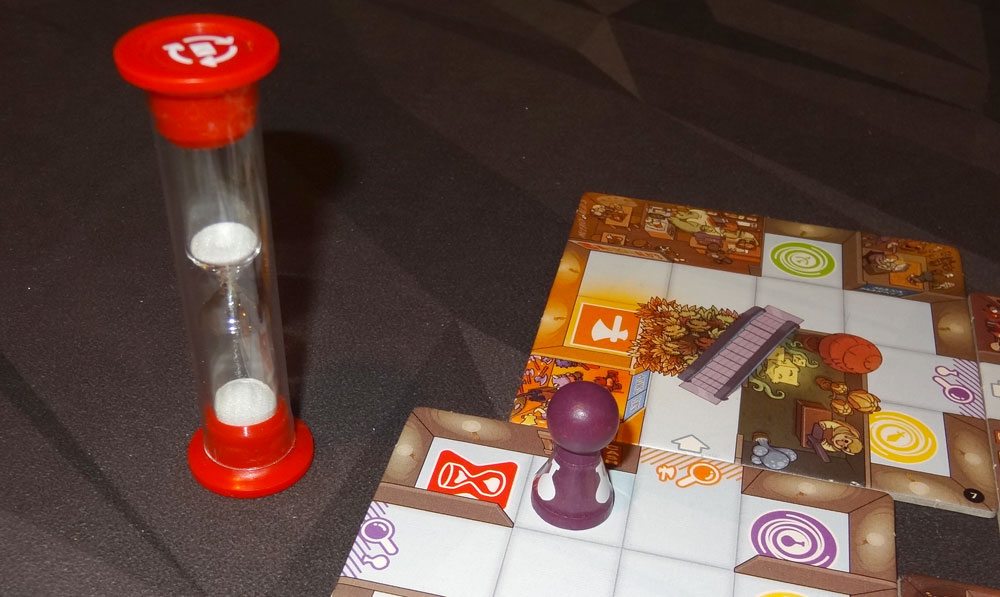
The Timer
When you’re ready to play, you flip the sand timer, which gives you three minutes. If the sand runs out, the game is over and you’re caught. Better luck next time!
“But wait,” you say, “I thought I got up to 15 minutes!”
There are some spaces on the Mall tiles with hourglass icons on them. Each time a pawn is moved to an hourglass, you immediately flip the sand timer over (no matter how much or how little sand is left). Then place an Out of Order token on that hourglass icon—it can no longer be used for the rest of the game. There are four hourglass icons total, so if you always flip the sand timer at the best moment, you’ll get 15 minutes total.
In the full ruleset, every time the timer flips, you also pass your Action tile to the left, so everyone has new actions.
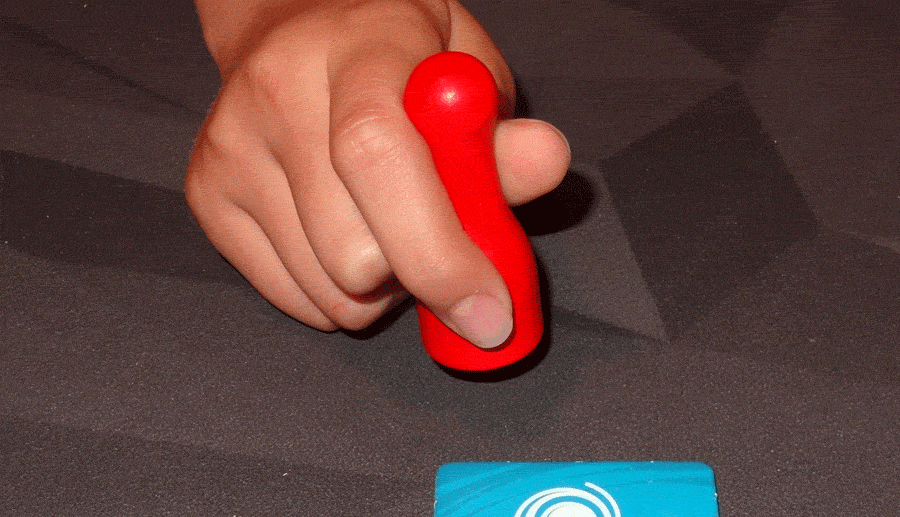
Quiet, Please!
In the introductory scenario, you’re allowed to talk to each other, but don’t get too comfortable. This is a heist: you can’t be blabbing the whole time. Every time the sand timer is flipped (including the start of the game), you are allowed to talk as much as you want… until somebody moves. Once any pawn has been moved, you may not talk until the next time the timer is flipped.
There are two ways you’re allowed to communicate: stare intensely at somebody, or take the “Do Something!” pawn and put it in front of somebody. Of course, you can’t tell them what you want them to do—just that you expect them to do something. In our games, we rarely resort to staring because it’s so much more fun (if not necessarily effective) to pound on the table with the giant red pawn.

How to Get the Goods
The four thieves—I mean, heroes—will only pull off the heist when all four are in their matching stores. (It has to be a simultaneous heist, of course, because, otherwise, the first theft will tip off mall security.) Once all four have made it, the heist occurs, and you flip over the Theft tile (and the Action tile with the Warp action). There’s now a big red X over the warp symbol, because the mall has shut down the vortex system and you’ll have to escape on foot.
Now, get all four pawns to the exit(s) to win the game.

The Full Monty
As you work your way through the introductory scenarios, you’ll add more Mall tiles to the stack, which makes it harder to find the stores and the exits, and the four heroes gain specific abilities as well.
The orange Dwarf is the only one who can pass through the low archways—everyone else has to go around.
The yellow Barbarian can shut down security cameras. When there are two or more active security cameras on the map, you may not use hourglass spaces.
The purple Mage can use Crystal Ball spaces: the player with the Explore action may immediately place two more tiles in any valid locations, and then put an Out of Order token on the Crystal Ball.
The green Elf allows players to communicate every time it explores: when the new tile is placed, players may talk as if the sand timer were flipped, until anyone moves a pawn.
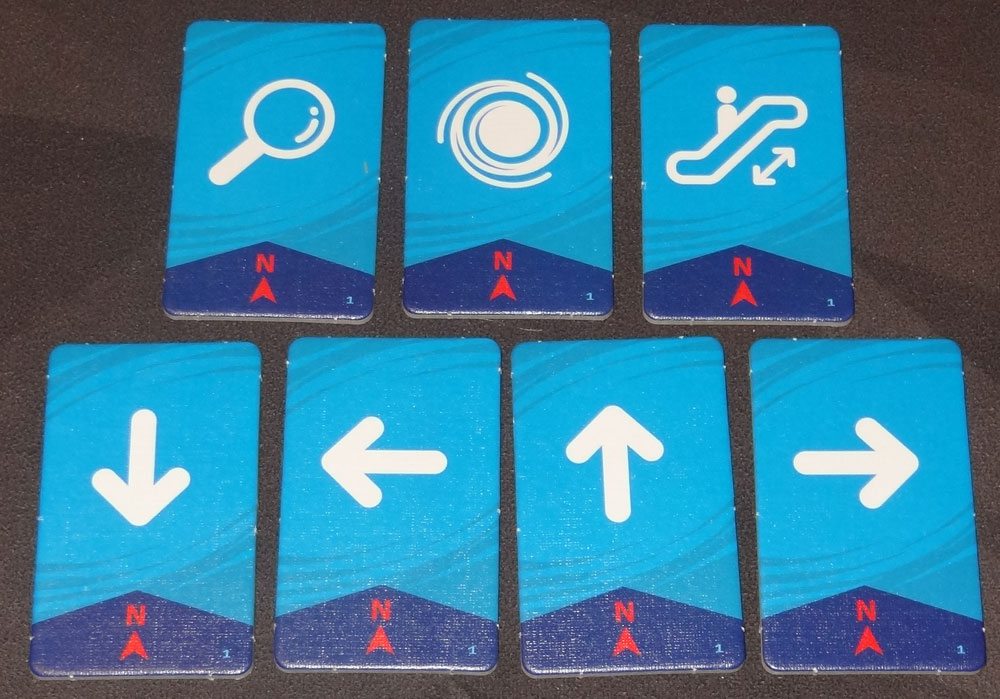
Solo Play
Solo play uses similar rules, but the Action tiles are different. You use the set of 7 solitaire tiles, which each have only one direction or one action. You shuffle the Action tiles and place them in a face-down stack. Using only one hand, you may flip Action tiles from the top of the deck into a discard pile. You may use whatever action is currently showing, as much as you want, but then you must flip to another tile to move in a different direction or get a different action. If you run out of tiles, you flip the whole discard pile over without changing the order.
Every time you flip the sand timer, you also shuffle the Action tiles.
Advanced Scenarios
There are ten additional scenarios for advanced play, once you’re familiar with the full ruleset. These involve tweaks and are not cumulative. For instance, “Trick the Guards” requires each hero to steal an item that is not theirs, and also use an exit that isn’t theirs (and hasn’t been used by anyone else). “Multidimensional Mall” has the mall on two planes of existence, and the only way to travel between the two is by warping. “You Have Beautiful Eyes” takes way the “Do Something!” pawn so that the only way you can communicate is by staring.
Watch Us Play!
I recorded this video of a game of Magic Maze—it’s the intro scenario rules but with all 4 exits, so there aren’t any of the special hero abilities and additional tiles, and we don’t swap Action tiles when the timer is flipped. The video is sped up, though the actual play time was about 8 minutes… and then our timer ran out just before the Barbarian escaped. (Sorry you can’t really see the sand timer in the video.)
The Verdict
I’ve had my copy of Magic Maze since April, and I’ve been excited to review it since I first played it but have been waiting on the US release. In the meantime, it was nominated for the Spiel des Jahres, reaffirming my own suspicions that this game was going to be a hit. I’ve logged over 30 plays of it (since it’s a short game, I often play a few times in a row), and have really enjoyed teaching it.
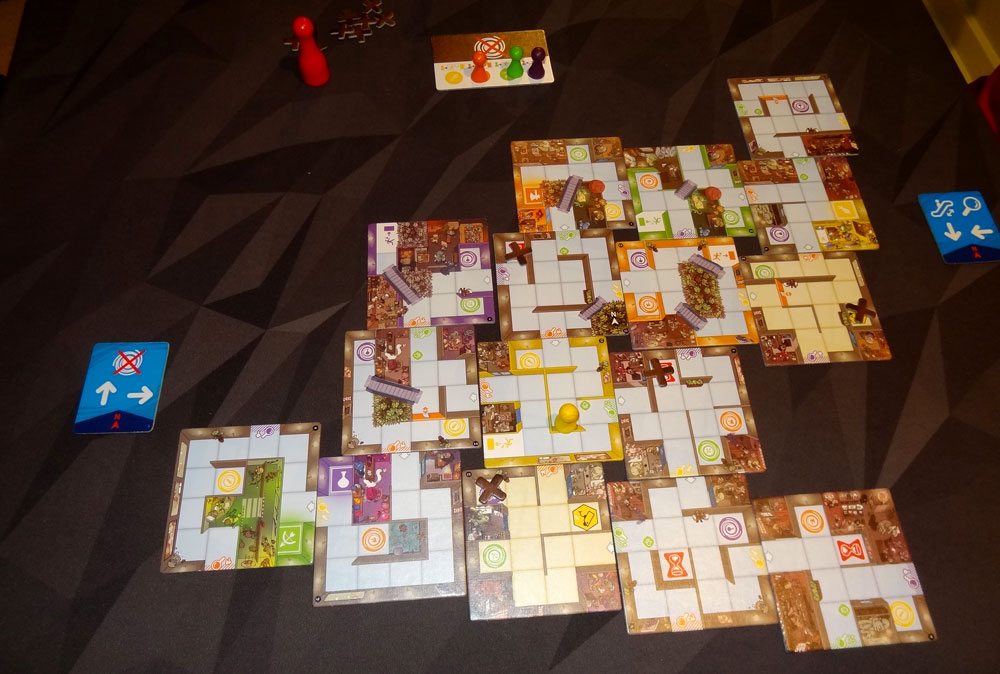
Why real time?
If you’ve never played a real-time game before, you may be wondering why anyone would want to play a game with no turns—isn’t that just chaotic? Well, yes. But real-time games are great for cracking down on two common problems in gaming: analysis paralysis (AP) and the alpha player (not AP, despite the matching initials).
Analysis paralysis is the situation where a player spends a long time agonizing over every potential move, comparing possible scores, thinking out what each opponent may do. It may involve moving things around, then rewinding and moving them around in a different way. It also involves some amount of groaning—from everyone else. When the timer’s running, though, you can’t spend precious minutes pondering your move, and neither can that guy.
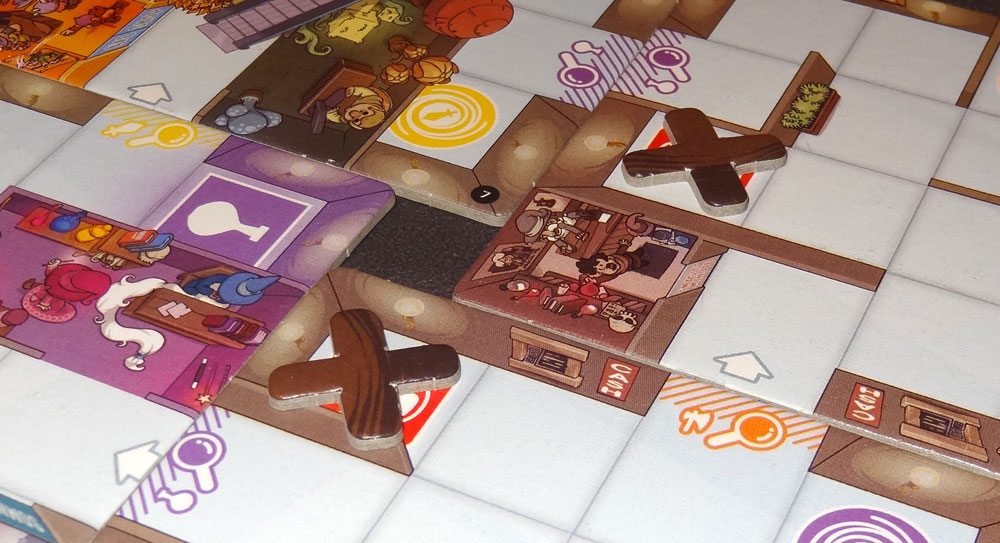
When cooperative games arrived on the scene, gamers quickly realized that the experience turns sour if one player takes over all the decision-making and just tells everyone what to do. Granted, cooperative games are sometimes puzzle-like with an optimal solution, and experienced players who really want to win won’t be shy about telling you what that solution is. But it’s not really fun if your game is essentially watching one person play solitaire. Many cooperative games now actively discourage alpha player syndrome by restricting information or using time pressure. Magic Maze does both: not only are you not allowed to talk most of the time, but you’re also racing the clock. And if somebody does try to take over and direct everyone while you’re allowed to talk? Well, you just move a pawn and they have to shut up.
Some other real-time games (like Space Cadets: Dice Duel and Escape) incorporate real time by having players roll dice simultaneously: you might know exactly what you want to do, but you can’t do it until you get the right results. Magic Maze takes a different approach: everyone is allowed to take their own actions whenever they want, but the trick is figuring out what to do. I’ll tell you: when somebody sticks that “Do Something!” pawn in front of you, your brain just freezes up, even if it’s totally obvious to everyone else.
Is Magic Maze fun?
Personally, I’m a huge fan of real-time games, and have played many of them (both cooperative and competitive) over the years. I like the tension of making tough decisions under pressure. That said, not everyone enjoys them. If you play games in order to sit back and relax, to ponder best moves and socialize over drinks during a game, Magic Maze might not be the best fit. Now, I like relaxing too, but I also love a game that gives a good jolt to everyone’s system.
For Magic Maze, I love the theme, too, because it’s just so absurd. The juxtaposition of traditional fantasy characters in something as mundane as a mall (albeit a mall with teleporting vortices and a changing layout) is funny, as is the premise of adventuring heroes stealing their equipment instead of earning it.
I also just love the chaos that ensues while everyone is trying to get our hapless heroes to their intended destinations. This game provokes a lot of laughter and groans and unintelligible mumbles (because you can’t talk).

Try the flip side of the entrance mall, which has more walls and no warp vortices. Photo: Jonathan H. Liu
Is Magic Maze hard?
For cooperative games, getting the right difficulty is important—too hard, and many players won’t want to try again. Too easy, and there’s no challenge. Most cooperative games have a way of increasing the difficulty (and, in general, expansions make it even harder for those players who have mastered the base game). I really like the way that Magic Maze ramps up gradually, increasing both the complexity and the difficulty as you learn the game. The overall complexity is not too high even with the full ruleset, but it definitely gets difficult to win—which is what you want out of a cooperative game.
The initial scenario, which allows full communication, no Action tile swapping, and only one exit for all four heroes, is fairly simple, and you will likely be able to accomplish it without needing to use too many hourglasses to extend the time. But finding your way through 24 tiles instead of 9 tiles, while dealing with security cameras and inconvenient walls and without any additional hourglasses, is certainly a bigger challenge. I do think that if you play with the same group, you will certainly get better at it, both at figuring out who should move what but also the unspoken communication.

It’s also easy, in the heat of the moment, to forget to keep an eye on the sand timer. You may have one player who sees it and is trying to maneuver a pawn toward an hourglass space, but everyone else thinks that pawn is headed to a store or to explore. I’ve lost many games simply because nobody noticed time was running out.
The additional scenarios really mix it up. I’ve read through the rules but actually haven’t tried any of them myself yet because I’ve usually been teaching new players, so we often haven’t built up to the full ruleset for everyone yet. I’m glad that the options are available, though, because if I ever do play with the same group often enough to build up proficiency, it will be nice to change things up.
There’s also an expansion coming this fall at Spiele called Maximum Security, which will include many new rules that you can pick and choose to add to the base game—I can’t wait to see what it includes!

How is the solo mode?
I’ve tried the basic scenario using the solitaire rules and I can confirm that it’s pretty challenging. Maneuvering the four pawns on your own with only one action available at a time is tough, particularly when you add in the restriction that you can only use one hand. You’ll find yourself flipping through the entire stack of Action tiles just to get to a particular action… and then realize that you’ll have to go through almost the whole pile again to get to your next required action. And once the heist occurs and the warp action is unavailable? Well, you’ll just have to flip past that tile every time it comes up.
I was barely able to survive the basic mode—I’ll definitely have to work my way up to the full set of rules. I do like that there’s a solitaire mode, but it feels more like a speed/dexterity game than the group-think challenge of the regular game, and I prefer the multiplayer mode.
How does Magic Maze stack up in the Spiel des Jahres competition?
So far, of the three nominees for this year’s Spiel des Jahres, I’ve played Kingdomino (also a GeekDad Approved title) and Magic Maze. Of the two, I would have trouble choosing a favorite (and thus I’m glad I’m not on the SdJ committee). They’re both excellent games with very different play styles. Kingdomino is a bit like Carcassonne: strategic tile-laying, with a little bit of bidding thrown in. It’s great for a smaller group and lets you put your own kingdom together like a puzzle. It feels a bit more like a classic Euro-style game. Magic Maze is frantic and intense, a bit like Escape but perhaps a bit more strategic. It feels more like playing a videogame, something fresh and new.
I’ll be really pleased if either of them wins; I think it depends on whether your leaning is more toward “classic” or “innovative.” We’ll find out soon enough!

Who will like Magic Maze?
Hopefully, if you’ve read this far, you’ll have a good sense of whether Magic Maze is a good fit for your group. It’s one that I recommend for groups who are willing to try something a little wacky and off the beaten path. I love that it’s not really similar to anything else in my collection; the closest is perhaps Escape, but this doesn’t rely on the luck of a die roll. There’s luck in how the tiles are mixed, but everything else is totally driven by your group’s decisions. Which means that if you lose, you’ve got nobody to blame but yourself.
I love that it works with such a wide range of players. Once you get past 4, there will be repeats of the cardinal directions, and I highly recommend using the “rotate Action tiles” rule to keep people from getting bored of being “that other person who can move North.”
If you enjoy real-time games and cooperative games, I think you may get a kick out of Magic Maze.
Click here for a full index of our tabletop game reviews.
Disclosure: I received a review copy of Magic Maze from Dude Games.
